MERCEDES-BENZ G-CLASS SUV 2008 Owners Manual
Manufacturer: MERCEDES-BENZ, Model Year: 2008, Model line: G-CLASS SUV, Model: MERCEDES-BENZ G-CLASS SUV 2008Pages: 293, PDF Size: 4.49 MB
Page 251 of 293
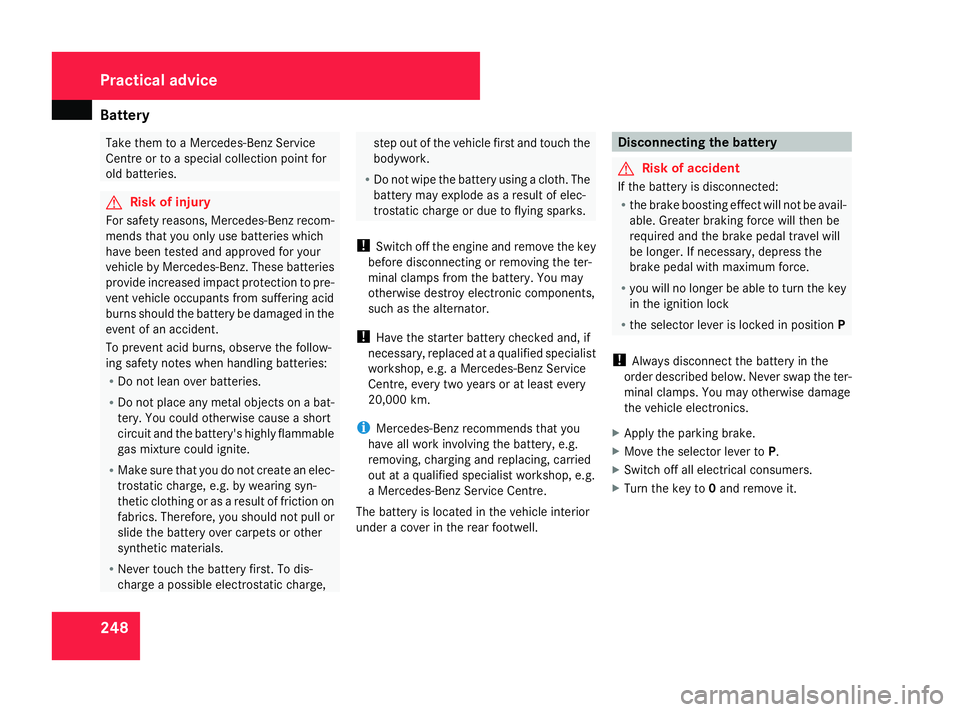
Battery
248 Take them to a Mercedes-Benz Service
Centre or to a special collection point for
old batteries. G
Risk of injury
For safety reasons, Mercedes-Benz recom-
mends that you only use batteries which
have been tested and approved for your
vehicle by Mercedes-Benz. These batteries
provide increased impact protection to pre-
vent vehicle occupants from suffering acid
burns should the battery be damaged in the
event of an accident.
To prevent acid burns, observe the follow-
ing safety notes when handling batteries:
R Do not lean over batteries.
R Do not place any metal objects on a bat-
tery. You could otherwise cause a short
circuit and the battery's highly flammable
gas mixture could ignite.
R Make sure that you do not create an elec-
trostatic charge, e.g. by wearing syn-
thetic clothing or as a result of friction on
fabrics. Therefore, you should not pull or
slide the battery over carpets or other
synthetic materials.
R Never touch the battery first. To dis-
charge a possible electrostatic charge, step out of the vehicle first and touch the
bodywork.
R Do not wipe the battery using a cloth. The
battery may explode as a result of elec-
trostatic charge or due to flying sparks.
! Switch off the engine and remove the key
before disconnecting or removing the ter-
minal clamps from the battery. You may
otherwise destroy electronic components,
such as the alternator.
! Have the starter battery checked and, if
necessary, replaced at a qualified specialist
workshop, e.g. a Mercedes-Benz Service
Centre, every two years or at least every
20,000 km.
i Mercedes-Benz recommends that you
have all work involving the battery, e.g.
removing, charging and replacing, carried
out at a qualified specialist workshop, e.g.
a Mercedes-Benz Service Centre.
The battery is located in the vehicle interior
under a cover in the rear footwell. Disconnecting the battery
G
Risk of accident
If the battery is disconnected:
R the brake boosting effect will not be avail-
able. Greater braking force will then be
required and the brake pedal travel will
be longer. If necessary, depress the
brake pedal with maximum force.
R you will no longer be able to turn the key
in the ignition lock
R the selector lever is locked in position P
! Always disconnect the battery in the
order described below. Never swap the ter-
minal clamps. You may otherwise damage
the vehicle electronics.
X Apply the parking brake.
X Move the selector lever to P.
X Switch off all electrical consumers.
X Turn the key to 0and remove it. Practical advice
463_AKB; 1; 8, en-GB
wobuchh,
Version: 2.10.6 2008-07-17T15:19:41+02:00 - Seite 248Dateiname: 6515_4091_02_buchblock.pdf; preflight
Page 252 of 293
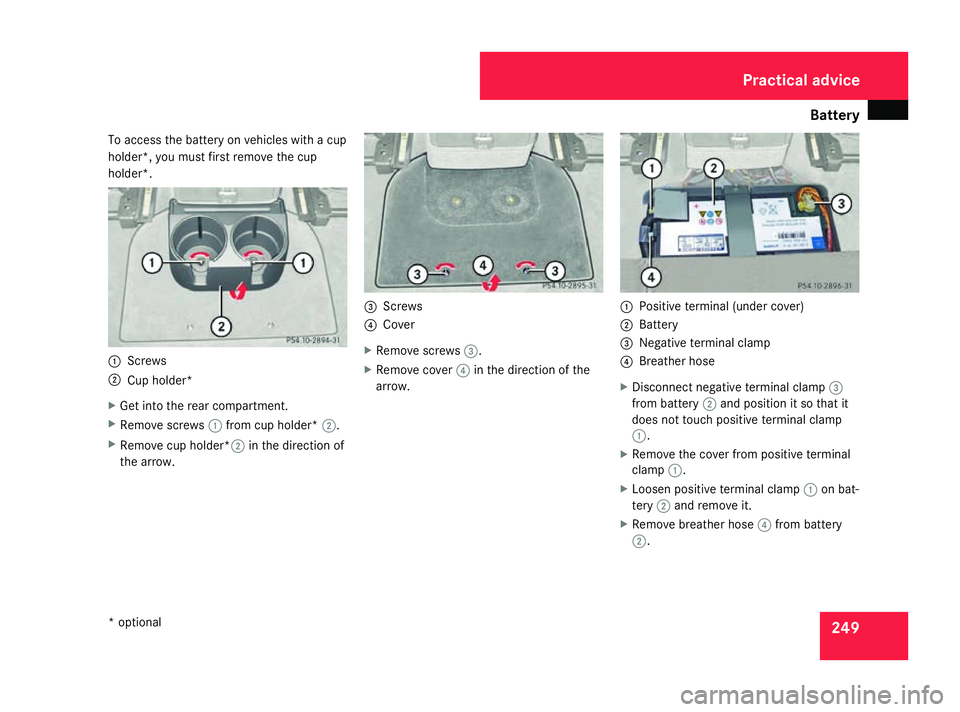
Battery
249
To access the battery on vehicles with a cup
holder*, you must first remove the cup
holder*.
1
Screws
2 Cup holder*
X Get into the rear compartment.
X Remove screws 1from cup holder* 2.
X Remove cup holder*2 in the direction of
the arrow. 3
Screws
4 Cover
X Remove screws 3.
X Remove cover 4in the direction of the
arrow. 1
Positive terminal (under cover)
2 Battery
3 Negative terminal clamp
4 Breather hose
X Disconnect negative terminal clamp 3
from battery 2and position it so that it
does not touch positive terminal clamp
1.
X Remove the cover from positive terminal
clamp 1.
X Loosen positive terminal clamp 1on bat-
tery 2and remove it.
X Remove breather hose 4from battery
2. Practical advice
* optional
463_AKB; 1; 8, en-GB
wobuchh,
Version: 2.10.6 2008-07-17T15:19:41+02:00 - Seite 249 ZDateiname: 6515_4091_02_buchblock.pdf; preflight
Page 253 of 293
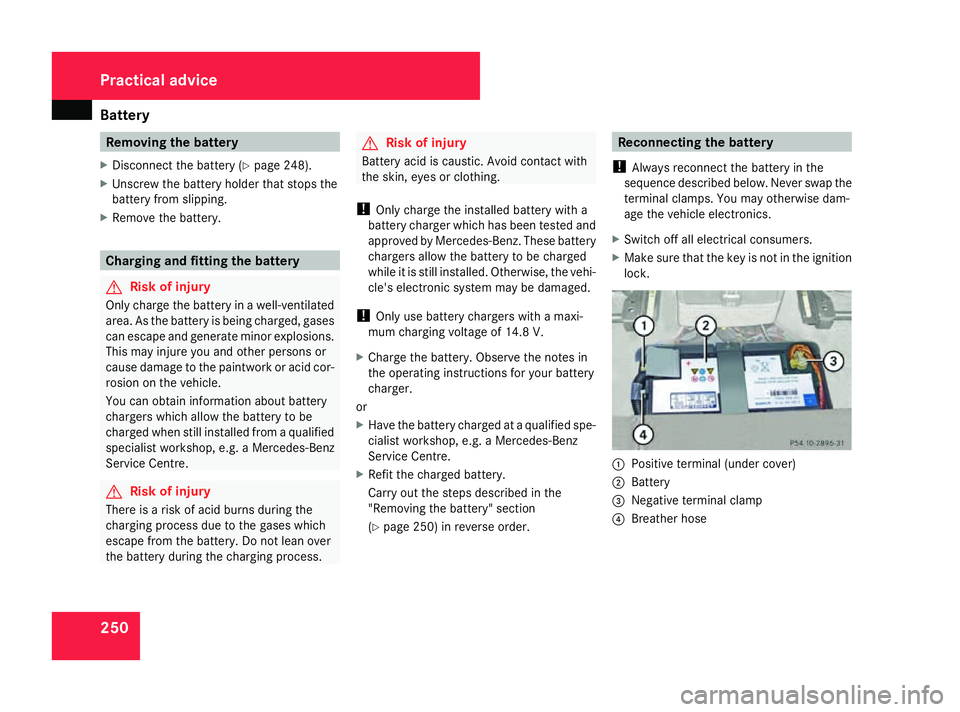
Battery
250 Removing the battery
X Disconnect the battery ( Ypage 248).
X Unscrew the battery holder that stops the
battery from slipping.
X Remove the battery. Charging and fitting the battery
G
Risk of injury
Only charge the battery in a well-ventilated
area. As the battery is being charged, gases
can escape and generate minor explosions.
This may injure you and other persons or
cause damage to the paintwork or acid cor-
rosion on the vehicle.
You can obtain information about battery
chargers which allow the battery to be
charged when still installed from a qualified
specialist workshop, e.g. a Mercedes-Benz
Service Centre. G
Risk of injury
There is a risk of acid burns during the
charging process due to the gases which
escape from the battery. Do not lean over
the battery during the charging process. G
Risk of injury
Battery acid is caustic. Avoid contact with
the skin, eyes or clothing.
! Only charge the installed battery with a
battery charger which has been tested and
approved by Mercedes-Benz. These battery
chargers allow the battery to be charged
while it is still installed. Otherwise, the vehi-
cle's electronic system may be damaged.
! Only use battery chargers with a maxi-
mum charging voltage of 14.8 V.
X Charge the battery. Observe the notes in
the operating instructions for your battery
charger.
or
X Have the battery charged at a qualified spe-
cialist workshop, e.g. a Mercedes-Benz
Service Centre.
X Refit the charged battery.
Carry out the steps described in the
"Removing the battery" section
(Y page 250) in reverse order. Reconnecting the battery
! Always reconnect the battery in the
sequence described below. Never swap the
terminal clamps. You may otherwise dam-
age the vehicle electronics.
X Switch off all electrical consumers.
X Make sure that the key is not in the ignition
lock. 1
Positive terminal (under cover)
2 Battery
3 Negative terminal clamp
4 Breather hose Practical advice
463_AKB; 1; 8, en-GB
wobuchh,
Version: 2.10.6 2008-07-17T15:19:41+02:00 - Seite 250Dateiname: 6515_4091_02_buchblock.pdf; preflight
Page 254 of 293
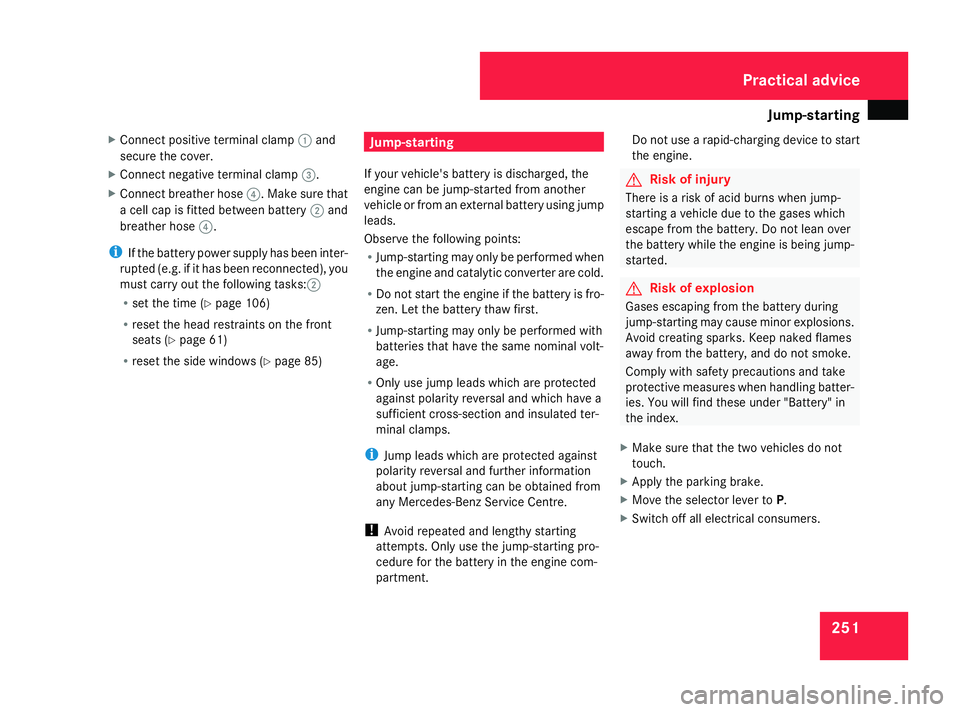
Jump-starting
251
X
Connect positive terminal clamp 1and
secure the cover.
X Connect negative terminal clamp 3.
X Connect breather hose 4. Make sure that
a cell cap is fitted between battery 2and
breather hose 4.
i If the battery power supply has been inter-
rupted (e.g. if it has been reconnected), you
must carry out the following tasks:2
R set the time (Y page 106)
R reset the head restraints on the front
seats (Y page 61)
R reset the side windows ( Ypage 85) Jump-starting
If your vehicle's battery is discharged, the
engine can be jump-started from another
vehicle or from an external battery using jump
leads.
Observe the following points:
R Jump-starting may only be performed when
the engine and catalytic converter are cold.
R Do not start the engine if the battery is fro-
zen. Let the battery thaw first.
R Jump-starting may only be performed with
batteries that have the same nominal volt-
age.
R Only use jump leads which are protected
against polarity reversal and which have a
sufficient cross-section and insulated ter-
minal clamps.
i Jump leads which are protected against
polarity reversal and further information
about jump-starting can be obtained from
any Mercedes-Benz Service Centre.
! Avoid repeated and lengthy starting
attempts. Only use the jump-starting pro-
cedure for the battery in the engine com-
partment. Do not use a rapid-charging device to start
the engine. G
Risk of injury
There is a risk of acid burns when jump-
starting a vehicle due to the gases which
escape from the battery. Do not lean over
the battery while the engine is being jump-
started. G
Risk of explosion
Gases escaping from the battery during
jump-starting may cause minor explosions.
Avoid creating sparks. Keep naked flames
away from the battery, and do not smoke.
Comply with safety precautions and take
protective measures when handling batter-
ies. You will find these under "Battery" in
the index.
X Make sure that the two vehicles do not
touch.
X Apply the parking brake.
X Move the selector lever to P.
X Switch off all electrical consumers. Practical advice
463_AKB; 1; 8, en-GB
wobuchh,
Version: 2.10.6 2008-07-17T15:19:41+02:00 - Seite 251 ZDateiname: 6515_4091_02_buchblock.pdf; preflight
Page 255 of 293
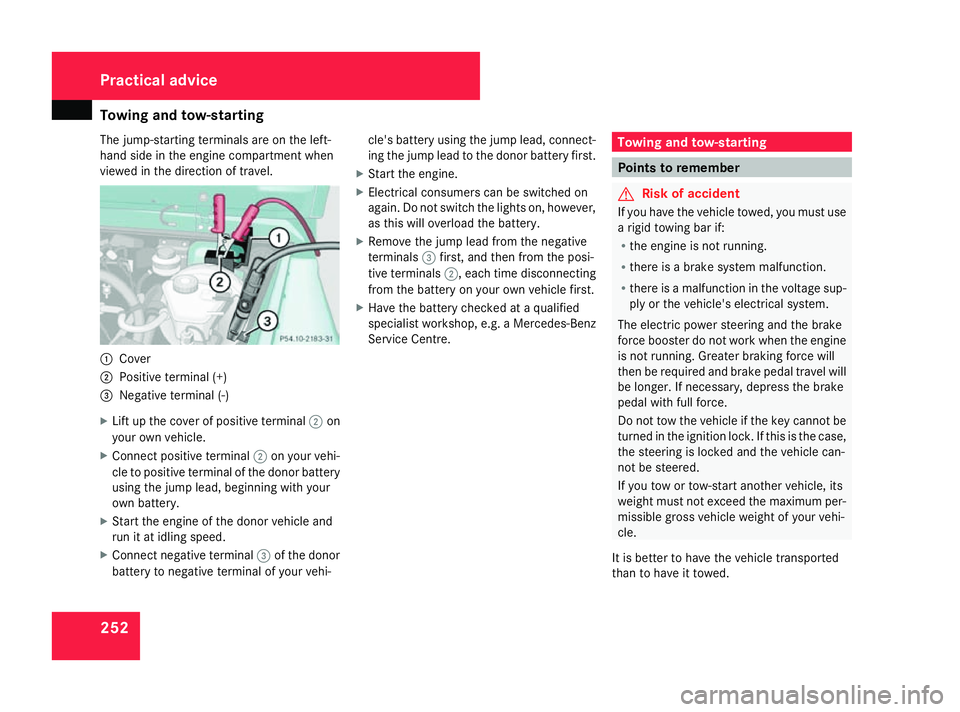
Towing and tow-starting
252
The jump-starting terminals are on the left-
hand side in the engine compartment when
viewed in the direction of travel. 1
Cover
2 Positive terminal (+)
3 Negative terminal (-)
X Lift up the cover of positive terminal 2on
your own vehicle.
X Connect positive terminal 2on your vehi-
cle to positive terminal of the donor battery
using the jump lead, beginning with your
own battery.
X Start the engine of the donor vehicle and
run it at idling speed.
X Connect negative terminal 3of the donor
battery to negative terminal of your vehi- cle's battery using the jump lead, connect-
ing the jump lead to the donor battery first.
X Start the engine.
X Electrical consumers can be switched on
again. Do not switch the lights on, however,
as this will overload the battery.
X Remove the jump lead from the negative
terminals 3first, and then from the posi-
tive terminals 2, each time disconnecting
from the battery on your own vehicle first.
X Have the battery checked at a qualified
specialist workshop, e.g. a Mercedes-Benz
Service Centre. Towing and tow-starting
Points to remember
G
Risk of accident
If you have the vehicle towed, you must use
a rigid towing bar if:
R the engine is not running.
R there is a brake system malfunction.
R there is a malfunction in the voltage sup-
ply or the vehicle's electrical system.
The electric power steering and the brake
force booster do not work when the engine
is not running. Greater braking force will
then be required and brake pedal travel will
be longer. If necessary, depress the brake
pedal with full force.
Do not tow the vehicle if the key cannot be
turned in the ignition lock. If this is the case,
the steering is locked and the vehicle can-
not be steered.
If you tow or tow-start another vehicle, its
weight must not exceed the maximum per-
missible gross vehicle weight of your vehi-
cle.
It is better to have the vehicle transported
than to have it towed. Practical advice
463_AKB; 1; 8, en-GB
wobuchh
, Version: 2.10.6
2008-07-17T15:19:41+02:00 - Seite 252 Dateiname: 6515_4091_02_buchblock.pdf; preflight
Page 256 of 293
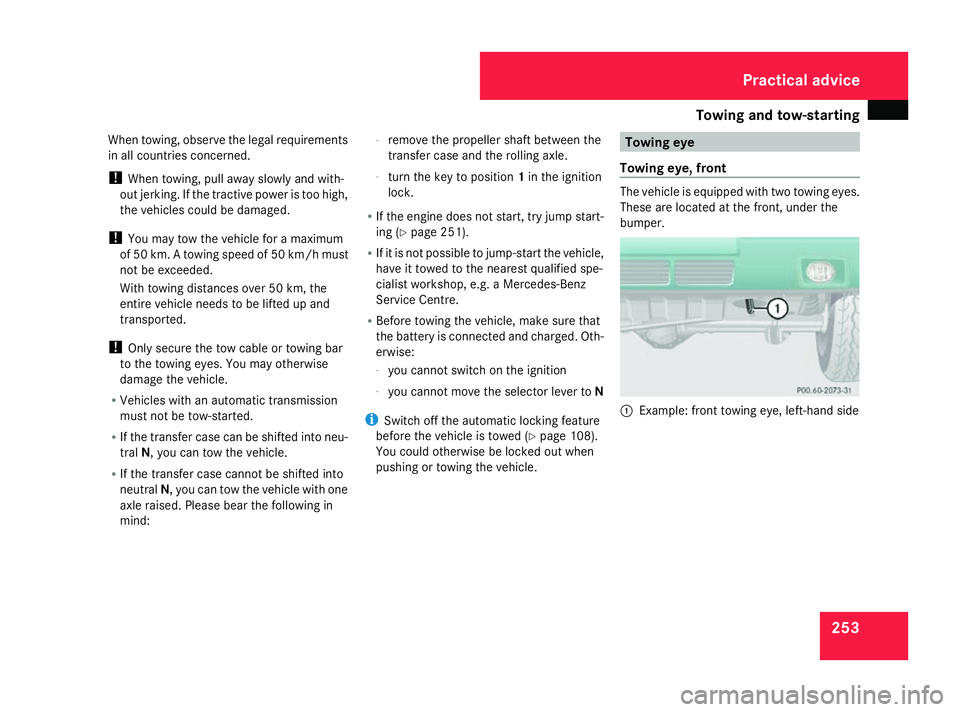
Towing and tow-starting
253
When towing, observe the legal requirements
in all countries concerned.
!
When towing, pull away slowly and with-
out jerking. If the tractive power is too high,
the vehicles could be damaged.
! You may tow the vehicle for a maximum
of 50 km. A towing speed of 50 km/h must
not be exceeded.
With towing distances over 50 km, the
entire vehicle needs to be lifted up and
transported.
! Only secure the tow cable or towing bar
to the towing eyes. You may otherwise
damage the vehicle.
R Vehicles with an automatic transmission
must not be tow-started.
R If the transfer case can be shifted into neu-
tral N, you can tow the vehicle.
R If the transfer case cannot be shifted into
neutral N, you can tow the vehicle with one
axle raised. Please bear the following in
mind: -
remove the propeller shaft between the
transfer case and the rolling axle.
- turn the key to position 1in the ignition
lock.
R If the engine does not start, try jump start-
ing (Y page 251).
R If it is not possible to jump-start the vehicle,
have it towed to the nearest qualified spe-
cialist workshop, e.g. a Mercedes-Benz
Service Centre.
R Before towing the vehicle, make sure that
the battery is connected and charged. Oth-
erwise:
- you cannot switch on the ignition
- you cannot move the selector lever to N
i Switch off the automatic locking feature
before the vehicle is towed (Y page 108).
You could otherwise be locked out when
pushing or towing the vehicle. Towing eye
Towing eye, front The vehicle is equipped with two towing eyes.
These are located at the front, under the
bumper.
1
Example: front towing eye, left-hand side Practical advice
463_AKB; 1; 8, en-GB
wobuchh
,V ersion: 2.10.6
2008-07-17T15:19:41+02:00 - Seite 253 ZDateiname: 6515_4091_02_buchblock.pdf; preflight
Page 257 of 293
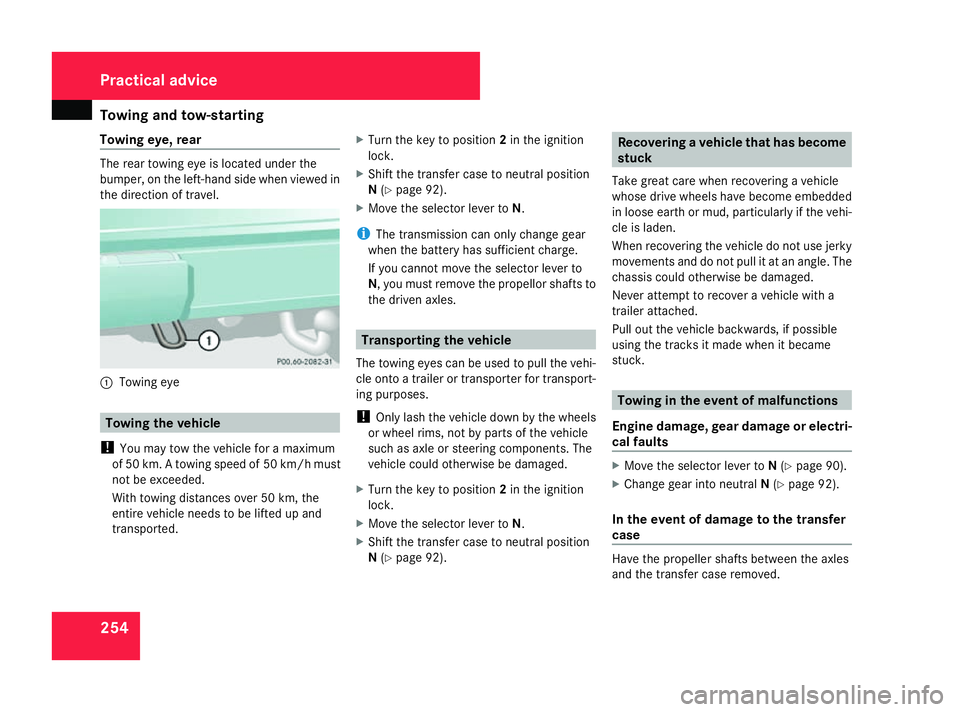
Towing and tow-starting
254
Towing eye, rear The rear towing eye is located under the
bumper, on the left-hand side when viewed in
the direction of travel. 1
Towing eye Towing the vehicle
! You may tow the vehicle for a maximum
of 50 km. A towing speed of 50 km/h must
not be exceeded.
With towing distances over 50 km, the
entire vehicle needs to be lifted up and
transported. X
Turn the key to position 2in the ignition
lock.
X Shift the transfer case to neutral position
N (Y page 92).
X Move the selector lever to N.
i The transmission can only change gear
when the battery has sufficient charge.
If you cannot move the selector lever to
N, you must remove the propellor shafts to
the driven axles. Transporting the vehicle
The towing eyes can be used to pull the vehi-
cle onto a trailer or transporter for transport-
ing purposes.
! Only lash the vehicle down by the wheels
or wheel rims, not by parts of the vehicle
such as axle or steering components. The
vehicle could otherwise be damaged.
X Turn the key to position 2in the ignition
lock.
X Move the selector lever to N.
X Shift the transfer case to neutral position
N (Y page 92). Recovering a vehicle that has become
stuck
Take great care when recovering a vehicle
whose drive wheels have become embedded
in loose earth or mud, particularly if the vehi-
cle is laden.
When recovering the vehicle do not use jerky
movements and do not pull it at an angle. The
chassis could otherwise be damaged.
Never attempt to recover a vehicle with a
trailer attached.
Pull out the vehicle backwards, if possible
using the tracks it made when it became
stuck. Towing in the event of malfunctions
Engine damage, gear damage or electri-
cal faults X
Move the selector lever to N(Y page 90).
X Change gear into neutral N(Y page 92).
In the event of damage to the transfer
case Have the propeller shafts between the axles
and the transfer case removed.Practical advice
463_AKB; 1; 8, en-GB
wobuchh
,V ersion: 2.10.6
2008-07-17T15:19:41+02:00 - Seite 254 Dateiname: 6515_4091_02_buchblock.pdf; preflight
Page 258 of 293
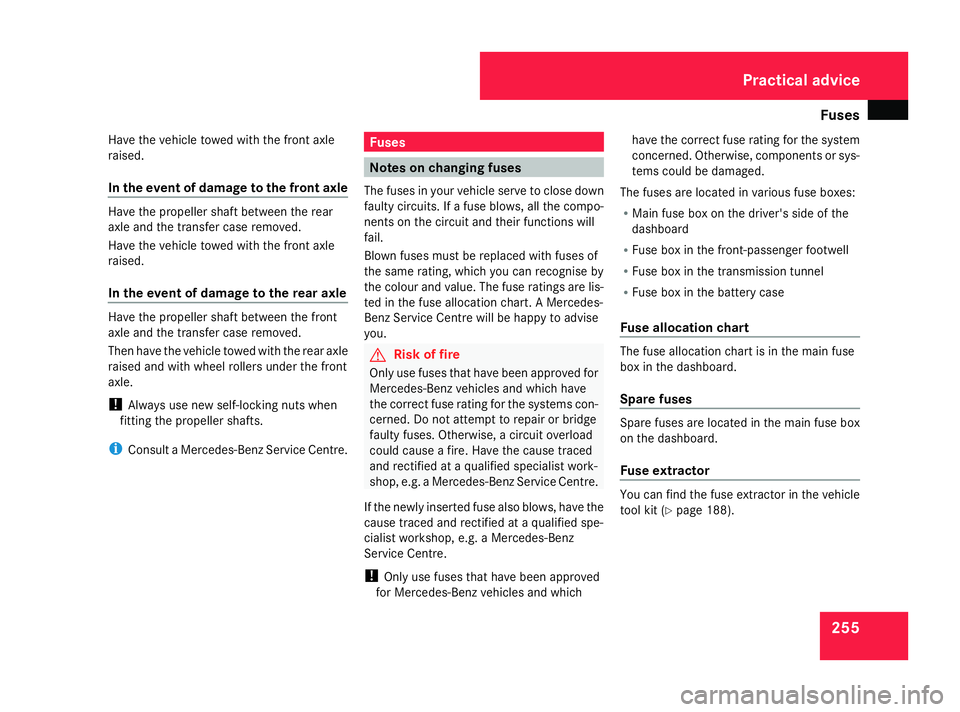
Fuses
255
Have the vehicle towed with the front axle
raised.
In the event of damage to the front axle Have the propeller shaft between the rear
axle and the transfer case removed.
Have the vehicle towed with the front axle
raised.
In the event of damage to the rear axle
Have the propeller shaft between the front
axle and the transfer case removed.
Then have the vehicle towed with the rear axle
raised and with wheel rollers under the front
axle.
!
Always use new self-locking nuts when
fitting the propeller shafts.
i Consult a Mercedes-Benz Service Centre. Fuses
Notes on changing fuses
The fuses in your vehicle serve to close down
faulty circuits. If a fuse blows, all the compo-
nents on the circuit and their functions will
fail.
Blown fuses must be replaced with fuses of
the same rating, which you can recognise by
the colour and value. The fuse ratings are lis-
ted in the fuse allocation chart. A Mercedes-
Benz Service Centre will be happy to advise
you. G
Risk of fire
Only use fuses that have been approved for
Mercedes-Benz vehicles and which have
the correct fuse rating for the systems con-
cerned. Do not attempt to repair or bridge
faulty fuses. Otherwise, a circuit overload
could cause a fire. Have the cause traced
and rectified at a qualified specialist work-
shop, e.g. a Mercedes-Benz Service Centre.
If the newly inserted fuse also blows, have the
cause traced and rectified at a qualified spe-
cialist workshop, e.g. a Mercedes-Benz
Service Centre.
! Only use fuses that have been approved
for Mercedes-Benz vehicles and which have the correct fuse rating for the system
concerned. Otherwise, components or sys-
tems could be damaged.
The fuses are located in various fuse boxes:
R Main fuse box on the driver's side of the
dashboard
R Fuse box in the front-passenger footwell
R Fuse box in the transmission tunnel
R Fuse box in the battery case
Fuse allocation chart The fuse allocation chart is in the main fuse
box in the dashboard.
Spare fuses
Spare fuses are located in the main fuse box
on the dashboard.
Fuse extractor
You can find the fuse extractor in the vehicle
tool kit (Y
page 188). Practical advice
463_AKB; 1; 8, en-GB
wobuchh,
Version: 2.10.6 2008-07-17T15:19:41+02:00 - Seite 255 ZDateiname: 6515_4091_02_buchblock.pdf; preflight
Page 259 of 293
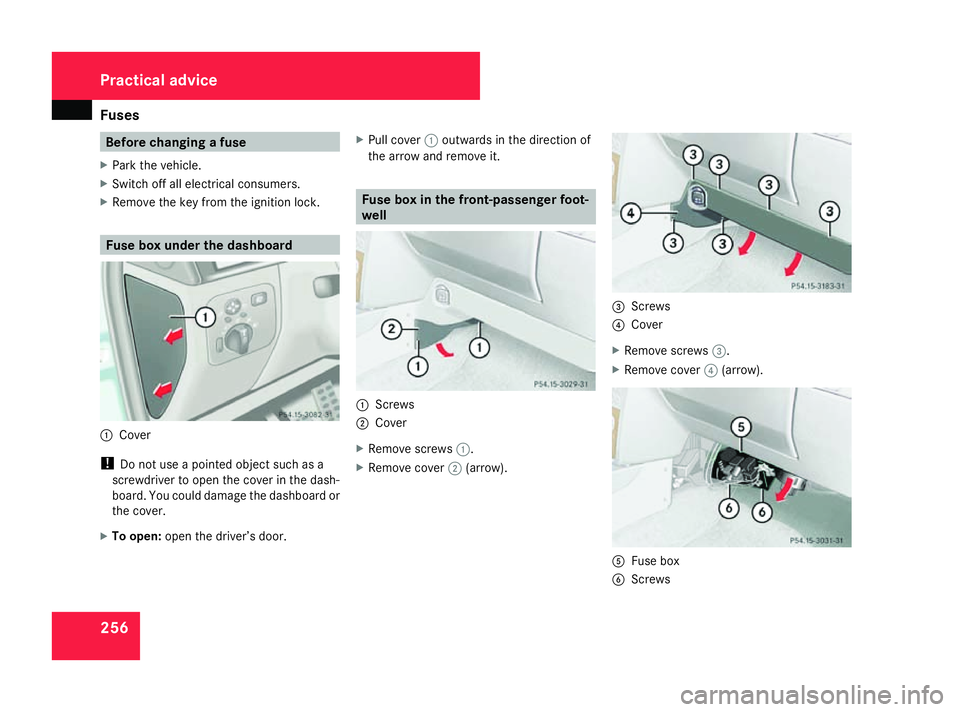
Fuses
256 Before changing a fuse
X Park the vehicle.
X Switch off all electrical consumers.
X Remove the key from the ignition lock. Fuse box under the dashboard
1
Cover
! Do not use a pointed object such as a
screwdriver to open the cover in the dash-
board. You could damage the dashboard or
the cover.
X To open: open the driver’s door. X
Pull cover 1outwards in the direction of
the arrow and remove it. Fuse box in the front-passenger foot-
well
1
Screws
2 Cover
X Remove screws 1.
X Remove cover 2(arrow). 3
Screws
4 Cover
X Remove screws 3.
X Remove cover 4(arrow). 5
Fuse box
6 Screws Practical advice
463_AKB; 1; 8, en-GB
wobuchh,
Version: 2.10.6 2008-07-17T15:19:41+02:00 - Seite 256Dateiname: 6515_4091_02_buchblock.pdf; preflight
Page 260 of 293
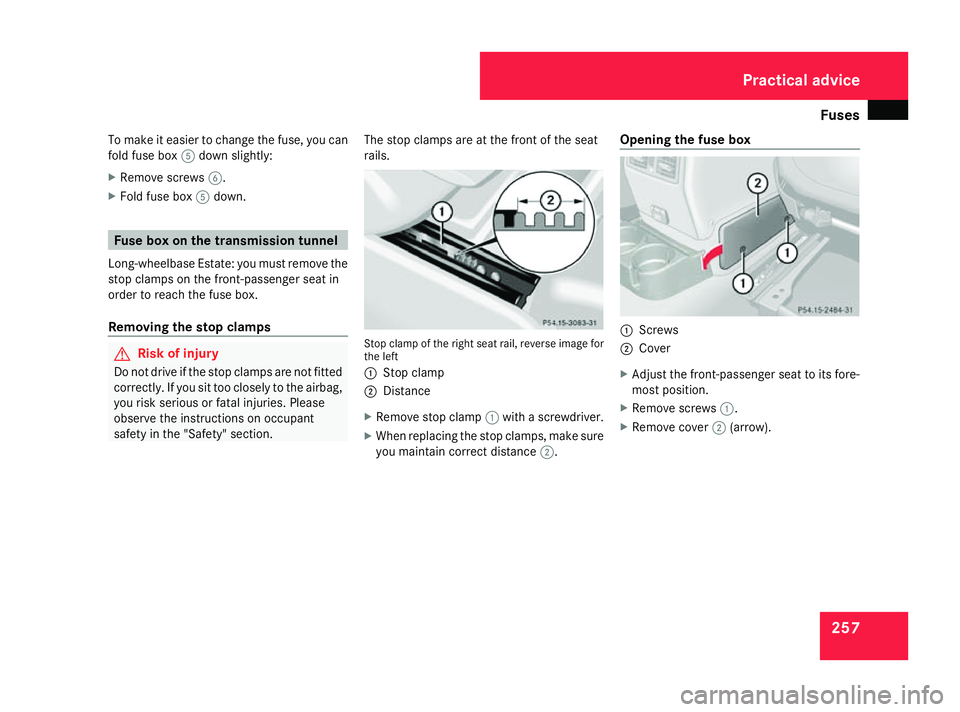
Fuses
257
To make it easier to change the fuse, you can
fold fuse box 5down slightly:
X Remove screws 6.
X Fold fuse box 5down. Fuse box on the transmission tunnel
Long-wheelbase Estate: you must remove the
stop clamps on the front-passenger seat in
order to reach the fuse box.
Removing the stop clamps G
Risk of injury
Do not drive if the stop clamps are not fitted
correctly. If you sit too closely to the airbag,
you risk serious or fatal injuries. Please
observe the instructions on occupant
safety in the "Safety" section. The stop clamps are at the front of the seat
rails. Stop clamp of the right seat rail, reverse image for
the left
1
Stop clamp
2 Distance
X Remove stop clamp 1with a screwdriver.
X When replacing the stop clamps, make sure
you maintain correct distance 2.Opening the fuse box 1
Screws
2 Cover
X Adjust the front-passenger seat to its fore-
most position.
X Remove screws 1.
X Remove cover 2(arrow). Practical advice
463_AKB; 1; 8, en-GB
wobuchh,
Version: 2.10.6 2008-07-17T15:19:41+02:00 - Seite 257 ZDateiname: 6515_4091_02_buchblock.pdf; preflight